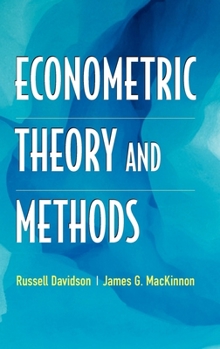Econometric Theory and Methods
Select Format
Select Condition 
Book Overview
Econometric Theory and Methods provides a unified treatment of modern econometric theory and practical econometric methods. The geometrical approach to least squares is emphasized, as is the method of moments, which is used to motivate a wide variety of estimators and tests. Simulation methods, including the bootstrap, are introduced early and used extensively.
The book deals with a large number of modern topics. In addition to bootstrap and Monte...
Format:Hardcover
Language:English
ISBN:0195123727
ISBN13:9780195123722
Release Date:October 2003
Publisher:Oxford University Press, USA
Length:768 Pages
Weight:2.60 lbs.
Dimensions:1.6" x 6.3" x 9.7"
Customer Reviews
4 ratings
Clear and self-contained
Published by Thriftbooks.com User , 15 years ago
This is a very good introductory econometrics textbook for the mathematically well-prepared. No prior knowledge of econometrics or statistics is assumed, and the discussion of the necessary probability and statistics concepts is integrated into the main text rather than being relegated to appendices. All you need to read this book is a good knowledge of linear algebra and calculus. Once you finish it you will have a firm grasp of the basic methods and models used by econometricians and be prepared for going to more advanced sources like Wooldridge's Econometric Analysis of Cross Section and Panel Data or Hamilton's Time Series Analysis Throughout the book Davidson and MacKinnon focus on developing intuition rather than on mechanical calculation. In particular, their geometric approach to ordinary least squares estimation is a must read. By focussing on the geometry and making clever use of the Frisch-Waugh-Lovell theorem, they make the properties of OLS very intuitive. Many of the standard results usually proved by opaque matrix algebra in other books, become clear and easy to prove in this framework. The book also has the advantage of covering topics like GMM estimation, the bootstrap and numerical methods that cannot be found in older textbooks. Yet, I have three quibbles with this book. The first, minor one, is that its treatment of time series methods is too short, and unlike the rest of the book tries to trade off depth for breadth. The second, bigger problem with this book is that it is entirely about econometric 'theory'. It teaches you how to find estimators and test statistics with good properties for particular models. But it does not train the student at all in the applied/methodological aspects of econometrics: given that I have a vague question about economic phenomena in mind, and given a bunch of data, how do I proceed? What questions can be meaningfully asked, how to choose between alternative models, how to present and interpret results, are questions that are given a short shrift in this book. Even data-based exercises are few and seem to have been reluctantly included. The third problem with this book is that it completely ignores the Bayesian approach to econometrics. Though this is in line with the general frequentist dominance of the econometrics profession, I feel that without at least an introduction to the Bayesian approach, the training of an econometrician will remain one-sided. The first two shortcomings of this book can be addressed by complementing it with Hayashi's Econometrics. Many interesting papers on methodology can be found in the book Modelling Economic Series edited by Granger.
Best buy
Published by Thriftbooks.com User , 20 years ago
Definitely the best and clearest book so far on this subject!! Written by a real top expert in this field (I took his course, the best eco. course I have taken). Much better than Green's book. If you are a serious graduate student in economics and management, especially those of you who are pursuing a PhD instead of only taking a course, it is the best for you. In-depth! Also frankly, it is not for a vaint brain and a guy with weak background.Only with this book and Johnston & Dinardo's, read and enjoy, then you will understand econometrics absolute confidently.Don't wast your money on other books!
The best so far!
Published by Thriftbooks.com User , 20 years ago
Of several graduate econometric textbooks I've read so far, this is the best. Compared to Greene (2003), its explanations are much clearer and its mathematical results are adequately derived. Compared to Johnston & Dinardo (1997), its coverage is more complete. Compared to Hayashi (2000), its discussion of IV method is more explicit. To be fair, however, Hayashi is also extemely well-written.
Excellent revision of a classic
Published by Thriftbooks.com User , 20 years ago
This new book is not a second edition of the classic 1993 book, but neither is it an `all new' one. Now the book is clearer and it is easier to build a Graduate Course using this reference. There are not considerable new topics. I think this 2004 edition should be considered a mere `lifting'. But it is worth the price. Work with this edition!




